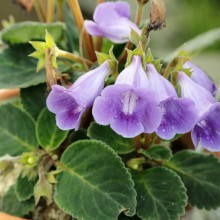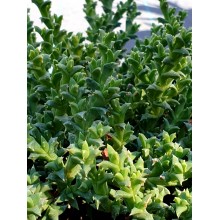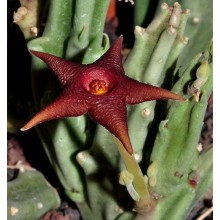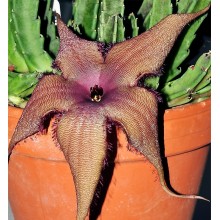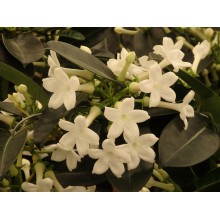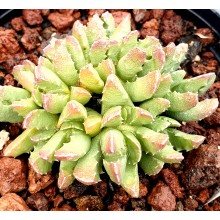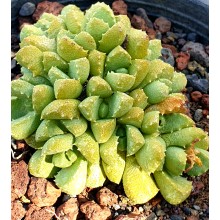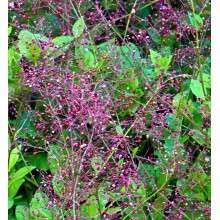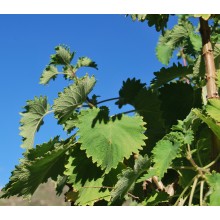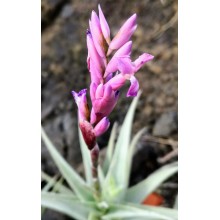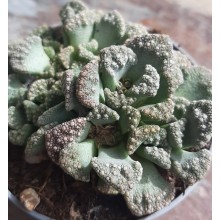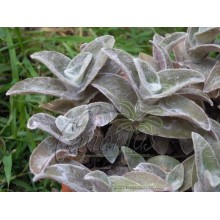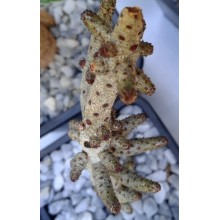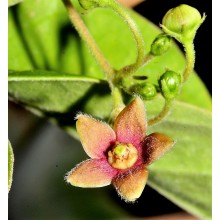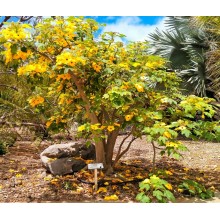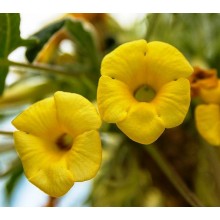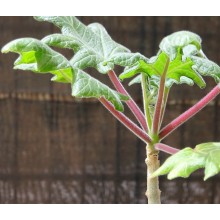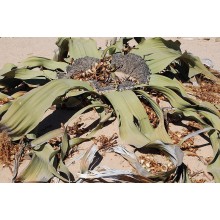Succulente Ci sono 628 prodotti.

I deserti del mondo e le zone secche ospitano le piante più interessanti. Canarius offre una selezione crescente di piante succulente di massima qualità, perché sono coltivate all'aperto, in pieno sole delle Isole Canarie.
I succulente o "piante grasse" sono specie di ritenzione di acqua, adattate alle condizioni di asciutto. Loro accumulano succum (succo, acqua) nelle loro foglie, steli o radici, e spesso mostrano un aspetto robusto e carnoso.
Sotto-categorie
-
Agave
Agave è un genere di piante grasse provenienti dall'America. Alcune specie crescono in zone fredde e possono sopportare un forte gelo, mentre altri vivono in climi tropicali. Alcuni sono piccoli nani e alcuni sono giganti, fino a 2 o 3 m di larghezza.
Le agavi resistenti al freddo possono creare un effetto esotico nel vostro giardino. Le specie agave fanno bella compagna di palme o cactus. Le agavi variegate sono incredibilmente ricercati dai collezionisti. Il nostro negozio web offre una selezione in continua evoluzione delle specie. Spediamo piante a radice nuda, se non diversamente specificato.
-
Aloe, Gasteria & Haworthia
Aloe, Gasteria e Haworthia sono tre generi correlate, comprese centinaia di piante succulente. Sono tutti facilmente coltivate in vaso. Alcuni si adattano a bassi livelli di luce di condizioni interne e possono essere coltivate come piante da appartamento.
- Aloe è un genere di circa 400 specie, originarie di Africa, Arabia e Madagascar. I aloe piccoli o nani stanno diventando particolarmente popolare in climi più freddi in quanto possono essere presi in casa durante i mesi più duri.
- Gasteria comprende circa 80 specie endemiche in Sud Africa, conosciuti per le loro foglie spettacolari che sono lucide, screziati e ruvidi. Fioriscono in primavera-estate con lunghe punte di piccoli fiori arancioni. Alcune specie sono talmente variabile che offriamo cloni particolari di località specifiche.
- Haworthia è un genere endemico in Sud Africa con circa 70 specie e un certo numero di sottospecie locali, varietà e forme. Le foglie sono spesso banded, punteggiati, punteggiato, o semi-trasparente e mostrano ampie variazioni.
-
Crassule
Questa è una nuova e crescente sezione di specie della famiglia Crassulaceae. Ci sono circa 1.400 specie in 33 generi et la loro distribuzione è in tutto il mondo, ma si presentano più nell'emisfero Nord e Sud Africa, in particolare in ambienti asciutti. Qui si possono acquistare piante sani, indurito dal sole, coltivati nelle isole Canarie e spediti a casa tua.
-
Mesembriantemi
Questo gruppo di piante del deserto è chiamato Mesembriantemi perché appartengono a una famiglia botanica precedentemente denominata Mesembryanthemaceae. Ci sono quasi 2.000 specie, che si trovano principalmente in Africa del sud, con adattamenti estremi agli habitat secco. Alcuni sono chiamati "pietre vive", perché sembrano come ciottoli. Molti sono facili da coltivare e il loro bisogno principale è pieno sole. Alcuni sono difficili perché crescono nelle aree veramente estreme.
Il nostro Web Shop offriamo piante sane coltivate al sole, con foglie compatte e colorate. Alcune piante sono venduti come talee, e altri come piante radicate, di almeno due anni. -
Sansevieria
Recentemente assegnato alla famiglia Asparagaceae, il genere Sansevieria conta circa 70 specie, quasi tutti nativi in Africa, Arabia e Madagascar. Erbe perenni adatti per gli habitat secchi con foglie rigide, succulente, la loro lunghezza varia da pochi centimetri a 2 metri. Sansevieria trifasciata e le sue numerose cultivar sono tra le piante d'appartamento più apprezzati, popolarmente chiamata la lingua di suocera. Una pianta ben coltivata di solito produce un picco di molti fiori bianchi, riccamente profumati e poi bacche arancioni. Anche le specie più rare sono resistenti ad abbandono, a condizione di tenerli dal gelo in inverno e sole cocente in estate.
-
Hoya
Le Hoyas sono rampicanti, dai fiori esotici e spesso vistosi. Provengono dalle foreste pluviali in Asia e Oceania. La maggior parte delle specie vive bene a mezz' ombra e si adatanno a vivere in casa come piante da appartamento. Sono ideali per cesti e tralicci. Tollerano un paio di settimane di siccità, ma sono sensibili al gelo e freddo. Molte hoya i sono facili da far crescere e fiorire, mentre alcune sono difficili e rare.
-
Asclepiadaceae
Le Asclepiade, o Asclepiadoideae, sono una sottofamiglia delle Apocynaceae, che annoverano circa 2900 specie diverse. Tra queste si trovano molti fusti privi di foglie ma anche erbe perenni, arbsuti, liane e, raramente, alberi. Producono fiori molto belli, dato il complesso sistema di impollinazione. Molte specie producono un odore insolito, spesso associato a quello di una carogna, la cui funzione è quella di attrarre le mosche che poi andranno a impollinare i fiori. -
Caudiciformi
Queste piante, dette anche pachicauli, sono tipiche delle zone aride. Producono un tronco insolitamente grosso e sproporzionato, detto caudice (a volte anche tubero), spesso con ramificazioni. Il caudice può essere anche nascosto sottoterra, ma nella maggior parte dei casi ha sviluppo verso l'alto, dando luogo ad alberi dalla forma spettacolare. I caudiciformi più grandi sono i baobab. -
Altre succulente
Qui troverete tutte quelle specie di piante del deserto che non sono inclusi nella propria categoria. Metteremo qui tutte le piante provenienti da famiglie inusuali, diversi da Agavi, Aloe, Crassulaceae, Sansevieria, Mesembriantemi, Epiphytic cacti, etc.
-
Sinningia speciosa 'Pedra Lisa'
Sinningia speciosa 'Pedra Lisa'
This is a nice wild form of the popular semi-succulent gesneriad named Sinningia speciosa. It has almost-white flowers with dark throat and some mauve on the tube, Leaves are also nice with the typical velvety touch and pale veins contrasting with the much darker leaf blade.
18,20 € -
Smicrostigma viride
Smicrostigma viride
Succulent shrublet of just 10-40 cm, from the Cape of South Africa. Curved green stems, made of "pairs of leaves" branch geometrically, creating an intriguing pattern.
10,30 € -
Stephanotis floribunda
Stephanotis floribunda
Succulent vine from Madagascar with pure white flowers of unrivalled beauty and fragrance. It grows outdoors in warm mediterranean to tropical conditions.
19,80 € -
Stomatium loganii
Stomatium loganii
This native of the Western cape has Jade coloured leaves and night-scented yellow flowers. Stomatium species come from inland So. Africa and they are hardy to frost.
10,80 € -
Stomatium mustelinum
Stomatium mustelinum
Nice-looking mesemb with gray warty leaves. It forms very cute low clumps or carpets and blooms profusely with yellow flowers that open in the late afternoon and are scented through the night.
10,40 € -
Strelitzia reginae 'Juncea' - Large
Strelitzia reginae 'Juncea' - Large
This strelizia is adapted to harsh conditions and lacks normal leaves. Leaf stalks taper to a tip with no blade, so the leaves look like fleshy spikes. The flower is much like the popular bird of paradise.
68,90 € -
Talinum paniculatum
Talinum paniculatum
Tuberous-rooted perennial native to Tropical America, with fleshy leaves and delicate pink flowers followed by the small and colourful pink-white-yellow-red fruits. It is considered an ornamental, a caudiciform. a medicinal plant. and in some countries even used as a vegetable
11,50 € -
Tetradenia riparia
Tetradenia riparia
Ornamental and aromatic shrub. 1-3 m tall, with velvety leaves and stems, It is intensely perfumed when scrubbed and bears sprays of cream-white flowers.
18,30 € -
Tillandsia purpurea
Tillandsia purpurea
This species creeps on sand fields in the harshest desert conditions, where no other plants are seen in miles. Tillandsia purpurea is found by the border between Chile and Peru. Its purple-purpureous inflorescences are a show. This xeric bromeliad is also sought after by collectors of succulent plants.
14,50 € -
Tradescantia sillamontana
Tradescantia sillamontana
Beautiful wooly plant native to Mexico. It sheds all branches for a few weeks or few months in the bad season and then comes back. All leaves are coated with white threads and large pink flowers emerge profusely. It is very easy to grow.
11,20 € -
Tylecodon bucholzianus
Tylecodon bucholzianus
Miniature shrub from South Africa with a swollen base. It is a winter grower, but T. bucholzianus is the only species in its genus that can grow new branches without leaves.
11,20 € -
Tylophora indica
Tylophora indica
Important medicinal and endangered climber in the Asclepiad branch of the Apocynaceae family, commonly called as “Antmool”.
29,10 € -
Uncarina decaryi
Uncarina decaryi
Very ornamental caudex-forming shrub from Southern Madagascar. It is an easy species and it is rather fast growing and free-blooming when grown in hot coastal weather.
28,50 € -
Uncarina ihlenfeldtiana
Uncarina ihlenfeldtiana
Uncarina ihlenfeldtiana grows as a small, sparsely branched shrub and grows up to 3 meters high.
84,20 € -
Uncarina roeoesliana - Entire leaf form
Uncarina roeoesliana - Entire leaf form
Shrubby caudiciform from Madagascar, with a long flowering season. It can grow to anything between 40 cm and 2 m in height, according to the conditions. It was described as recently as 1996 by Dr. W. Rauh. This species has two forms, with different types of leaves. This is the entire leaf form. We offer a 1-2 year old caudex: 3-5 cm diameter
35,00 € -
Uncarina roeoesliana - Lobed leaf form
Uncarina roeoesliana - Lobed leaf form
Shrubby caudiciform from Madagascar, with a long flowering season. It can grow to anything between 40 cm and 2 m in height, according to the conditions. It was described as recently as 1996 by Dr. W. Rauh. This species has two forms, with different types of leaves. This is the entire leaf form. We offer a 1-2 year old caudex: 3-5 cm diameter
35,00 € -
Welwitschia mirabilis
Welwitschia mirabilis
Welwitschia is a myth of botany, being one the most unusual plants in this world. It came from a very ancient plant lineage and survived to the modern era in the barren deserts of Angola and Namibia.
144,60 €
Al momento ci sono pochi prodotti in questa categoria Succulente

























